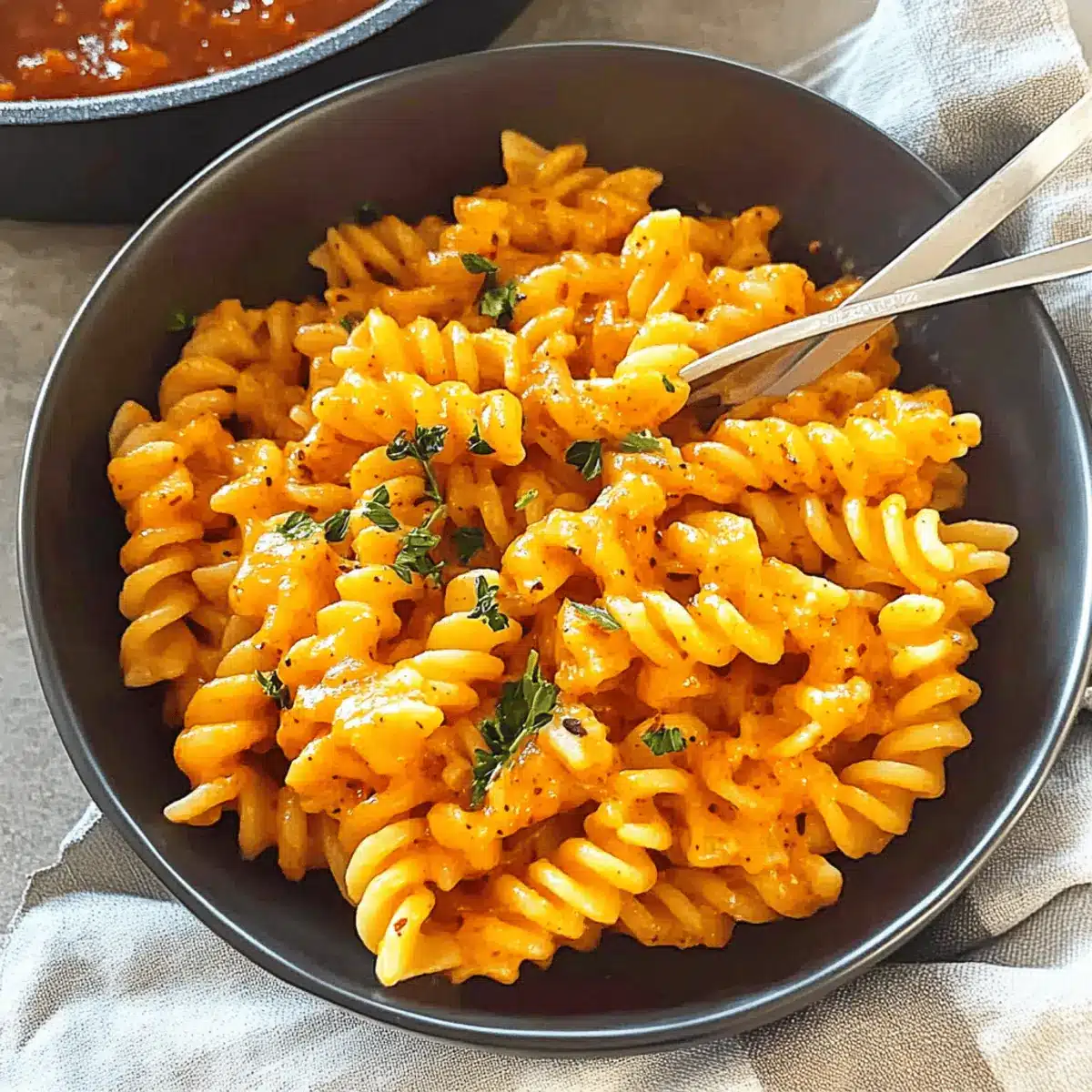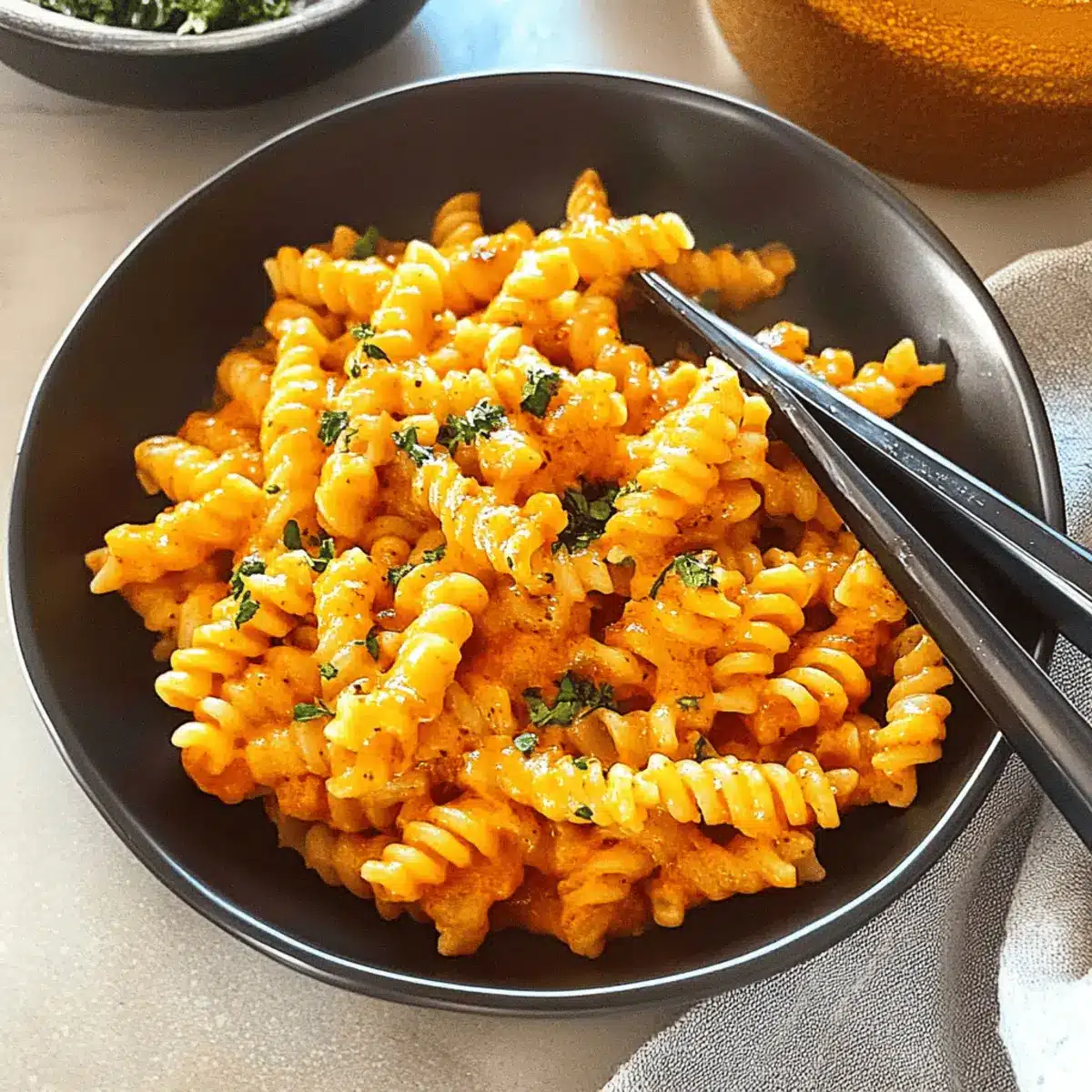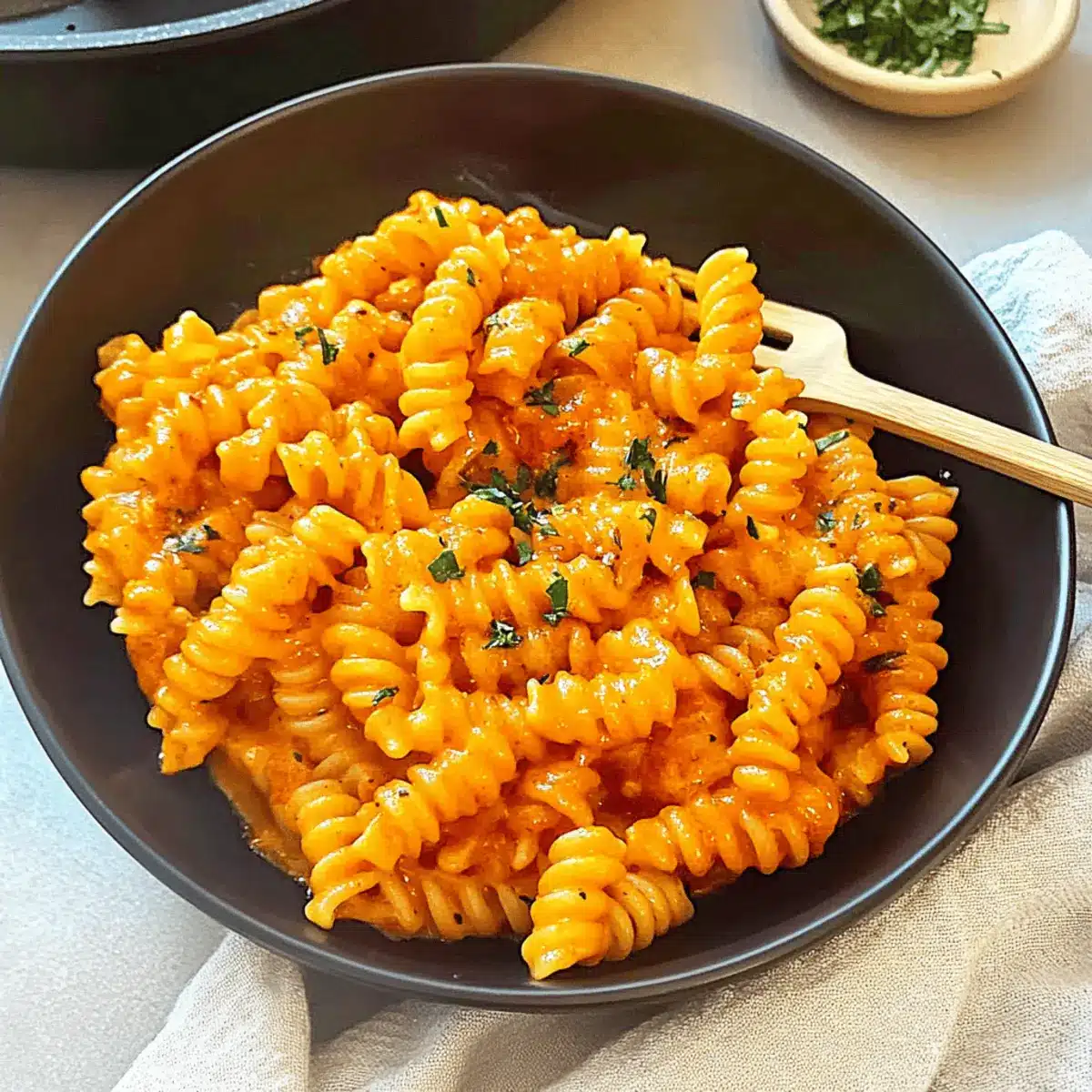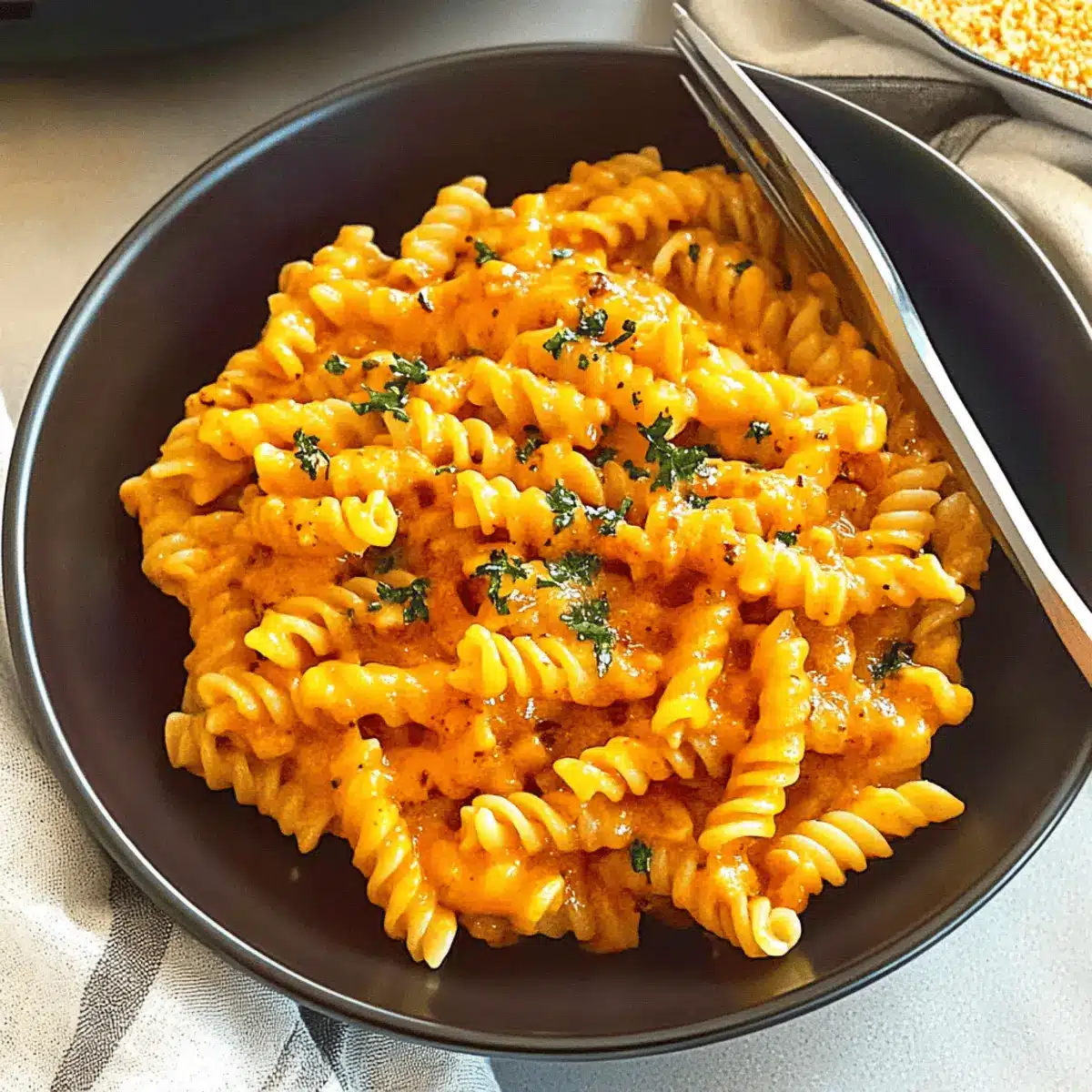The aroma is intoxicating as I whisk together a smooth, creamy sauce that sings with the spicy notes of gochujang. This Gochujang Pasta has quickly become my go-to recipe for busy weeknights, transforming mere spaghetti into a delightful culinary adventure in under 15 minutes. Imagine serving a dish that marries the comforting embrace of Italian pasta with the bold flavors of Korean cuisine; it’s an instant crowd-pleaser that’s both quick and incredibly satisfying. Plus, it’s easily adaptable—whether you prefer it vegan or with a touch of cheese, it meets everyone’s cravings. Ready to dive into this delicious fusion? Let’s whip up some pasta magic that might just become your new favorite!

Why is Gochujang Pasta a Must-Try?
Quick and Easy: You can whip this dish up in less than 15 minutes, perfect for those busy weeknights!
Unique Flavor Fusion: It combines the depth of Korean gochujang with creamy Italian pasta, offering a taste sensation that’s truly one-of-a-kind.
Versatile Options: Feel free to add proteins like grilled chicken or shrimp to transform your dish. Want a vegan option? Just swap in some plant-based milk and nutritional yeast!
Crowd-Pleasing: Impress your family or guests with a meal that looks as good as it tastes, making it perfect for quick dinners or fun get-togethers.
Satisfying and Comforting: The creamy texture together with the spicy components creates a delightful indulgence that will leave you craving more!
For a different take, try the Creamy Cajun Chicken Pasta or Cheeseburger Alfredo Pasta on your next pasta night!
Gochujang Pasta Ingredients
• Ready to gather what you’ll need for this delicious dish? Let’s dive in!
For the Pasta
- Fusilli Corti Bucati Pasta – The spiral shape holds the creamy sauce wonderfully; feel free to swap it with your favorite pasta.
For the Sauce
- Gochujang – This Korean chili paste brings the unique spicy-savory flavor to your Gochujang Pasta; ensure it’s labeled gluten-free if needed.
- Garlic (minced) – Freshly minced garlic elevates the dish with a delightful aroma and depth; don’t skip on this!
- Salted Butter – Adds richness to the sauce; use unsalted if you prefer better control over the salt content.
- Olive Oil – Helps sauté the garlic without burning and enhances the overall flavor.
- Shredded Parmesan/Cheddar Cheese – Provides creaminess; for a vegan version, substitute with nutritional yeast.
- Heavy Cream – This is what gives your sauce its luxurious, creamy texture; replace it with a plant-based milk for vegan options.
For Garnish
- Chopped Parsley – Brings a fresh element to your Gochujang Pasta; feel free to use cilantro or basil for a different twist.
- Freshly Ground Black Pepper – An optional addition for an extra touch of warmth and complexity.
Step‑by‑Step Instructions for Gochujang Pasta
Step 1: Boil the Pasta
Begin by bringing a large pot of salted water to a rolling boil over high heat. Once boiling, add the fusilli corti bucati pasta and cook for 7-12 minutes, stirring occasionally until al dente or to your preferred texture. You want the pasta to be tender but still firm. Once cooked, drain the pasta in a colander and set aside, allowing any excess water to drip off.
Step 2: Sauté the Garlic
In a large sauté pan, heat 2 tablespoons of salted butter and 1 tablespoon of olive oil over medium heat. Once the butter is melted and begins to bubble, add 2 cloves of minced garlic and an optional pinch of black pepper. Sauté for 30-60 seconds, stirring constantly until the garlic becomes fragrant and slightly golden, being careful not to burn it, as the garlic’s aroma will elevate your Gochujang Pasta.
Step 3: Create the Sauce
Next, stir in 2 tablespoons of gochujang, followed by 1 cup of heavy cream or your choice of plant-based milk for a vegan version. Mix well and allow it to cook for 1-2 minutes on medium heat until the sauce thickens slightly and is smooth. The rich, spicy flavor from the gochujang should blend beautifully with the cream, creating a lively red sauce that coats the pasta perfectly.
Step 4: Combine Pasta and Sauce
Lower the heat, and add the drained pasta directly into the pan with the creamy gochujang sauce. Toss the pasta gently, ensuring each piece is well coated with the sauce. Cook for an additional minute or two over low heat, allowing the flavors to meld together. The vivid color of the sauce should cling to the pasta, making it look irresistibly appetizing.
Step 5: Garnish and Serve
Once well combined, remove the pan from the heat. Sprinkle with freshly chopped parsley for a bright touch, and adjust seasoning with more black pepper if desired. Serve your Gochujang Pasta immediately, allowing guests to appreciate the vibrant presentation and aromatic flavors that promise a delightful synergy of Korean and Italian culinary styles.

What to Serve with Gochujang Pasta
Elevate your Gochujang Pasta experience by pairing it with delightful sides and complementary flavors that bring out its unique profile.
-
Garlic Bread: The buttery, crispy texture of garlic bread is perfect for soaking up the creamy sauce, adding a lovely crunch to every bite.
-
Asian-Inspired Salad: A vibrant mix of greens, cucumber, and sesame dressing with a hint of spice enhances the meal’s freshness and balances the richness.
Indulge in a side of seasoned roasted vegetables, such as bell peppers and zucchini. The earthiness of the veggies beautifully complements the spicy, creamy pasta.
-
Kimchi: This traditional Korean side dish brings tangy, fermented flavors that contrast wonderfully with the creamy sauce, creating a dynamic taste experience.
-
Chilled Soju: Enjoying a glass of this Korean spirit adds a refreshing kick and a cultural touch to your meal, rounding out the culinary adventure.
-
Coconut Sorbet: For dessert, a scoop of this light and creamy sorbet offers a refreshing, tropical finish to your satisfying dinner, cleansing the palate perfectly.
Expert Tips for Gochujang Pasta
-
Perfect Pasta Cooking: Always ensure your pasta is cooked al dente, as it will continue to cook slightly when mixed with the sauce, enhancing the texture.
-
Mind the Garlic: Sauté garlic until fragrant but not browned; burnt garlic can spoil the delicate flavors of your Gochujang Pasta.
-
Creamy Consistency: If the sauce is too thick, add a splash of pasta water before mixing in the cooked pasta for a smoother finish.
-
Spice Level Adjustment: Want more heat? Adjust the amount of gochujang in the sauce according to your spice preference for the perfect kick.
-
Add Fresh Elements: For brightness, include fresh herbs like parsley or a squeeze of lime right before serving, elevating the dish’s flavors beautifully.
How to Store and Freeze Gochujang Pasta
Fridge: Store any leftover Gochujang Pasta in an airtight container in the refrigerator for up to 5 days. Make sure to cool the pasta before storing to maintain its texture.
Freezer: If you want to freeze the pasta, portion it into freezer-safe containers or bags. It can be frozen for up to 3 months. Make sure to leave some space for expansion.
Reheating: When ready to enjoy, thaw in the refrigerator overnight. Reheat gently on the stovetop over low heat, adding a splash of milk or cream if the sauce thickens too much.
Freezing Tips: For best results, freeze the sauce separately from the pasta, as this helps maintain the creamy texture when reheated.
Make Ahead Options
These Creamy Gochujang Pasta dishes are perfect for busy home cooks looking to save time! You can prepare the sauce up to 3 days in advance; simply mix together the gochujang, garlic, heavy cream (or plant-based milk), and cheese before refrigerating in an airtight container. To maintain the sauce’s creamy texture, keep it stored away from moisture, which could cause separation. You can also cook the pasta a day ahead; just toss it in a bit of olive oil after cooling to prevent sticking. When it’s time to serve, reheat the sauce gently while adding the pasta, ensuring it warms through and combines beautifully for a delicious, quick meal!
Gochujang Pasta Variations & Substitutions
Feel free to mix things up with these fun variations to make this dish your own!
-
Protein Boost: Add grilled chicken, shrimp, or tofu for a hearty meal that satisfies all appetites. These additions not only elevate the dish but also provide essential nutrients.
-
Veggie Delight: Toss in sautéed or roasted vegetables like bell peppers, zucchini, or mushrooms for an extra dose of color and nutrition. The vegetables will add depth and texture to each bite.
-
Dairy-Free: For a completely vegan take, switch out the heavy cream for almond or soy milk and omit the cheese in favor of nutritional yeast. This way, you can still enjoy the creamy goodness without the dairy.
-
Spicy Kick: Crank up the heat by adding extra gochujang or some crushed red pepper flakes. Feel the intensity of flavor transform your dish into a spicy adventure!
-
Nutty Flavor: Consider stirring in a tablespoon of sesame oil at the end for a lovely nutty aroma that pairs beautifully with the gochujang.
-
Herbal Twist: Experiment with garnishing the dish with different herbs like cilantro or basil instead of parsley for an unexpected but delightful flavor contrast.
-
Serving Suggestions: Pair with Korean-style pickled radishes (Danmuji) or kimchi on the side to add even more authenticity and texture.
For a change of pace, don’t miss out on trying some Savory Butternut Squash Sage Pasta or the delightful Creamy Garlic Parmesan Chicken Pasta for your next meal!

Gochujang Pasta Recipe FAQs
What type of gochujang should I use for this recipe?
Absolutely! Look for gochujang labeled gluten-free if that’s a concern for you. The flavor can vary by brand, so I recommend tasting a spoonful for spice level before adding it to the sauce. A quality gochujang will bring depth and a perfect spicy-savory finish to your pasta.
How should I store leftovers?
Very! To keep your Gochujang Pasta fresh, place any leftovers in an airtight container and store them in the refrigerator for up to 5 days. Make sure to let the pasta cool down completely before sealing it to prevent condensation. This way, you can enjoy the flavors again without worry!
Can I freeze Gochujang Pasta?
Of course! If you’d like to freeze your pasta, portion it into freezer-safe containers or bags. It can be stored for up to 3 months. Just remember to leave some space in the containers as the dish may expand when frozen. To reheat, allow it to thaw in the refrigerator overnight and gently warm it on the stovetop.
What if my sauce becomes too thick when reheating?
No worries! If your sauce thickens too much during storage or reheating, simply add a splash of milk or cream while warming it on low heat. Stir well until the sauce reaches your desired consistency. It’s easy to bring that creamy texture back!
Is this recipe vegan-friendly?
Absolutely! You can easily make this dish vegan by swapping the heavy cream with a plant-based milk, like almond or soy milk, and replacing the cheese with nutritional yeast. This ensures everyone can enjoy a delightful bowl of Gochujang Pasta without compromising on flavor!
How can I tell if my pasta is cooked perfectly?
Great question! I recommend tasting the pasta while it cooks; it should be al dente, meaning it’s tender yet still firm when bitten. This texture allows the pasta to soak up the sauce without becoming mushy. Keep an eye on it, typically a cooking time of 7-12 minutes does the trick!

Spicy Comfort: Creamy Gochujang Pasta in 15 Minutes
Ingredients
Equipment
Method
- Boil the pasta in salted water for 7-12 minutes until al dente, then drain.
- Sauté garlic in butter and olive oil until fragrant, about 30-60 seconds.
- Stir in gochujang and heavy cream; cook for 1-2 minutes until thickened.
- Combine the drained pasta with the sauce, tossing gently over low heat.
- Garnish with parsley and pepper before serving.

Leave a Reply